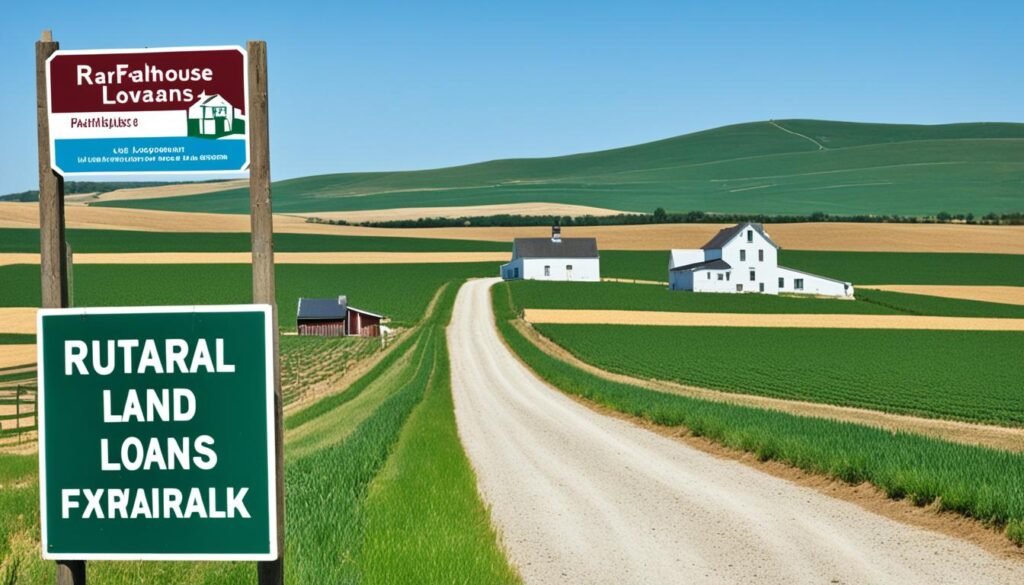Purchasing land involves selecting the right location, negotiating prices, and securing suitable financing. Land loans, unlike standard mortgages, have distinct requirements and terms for different types of land purchases, such as lot loans, raw land loans, and construction loans. The choice of lender, ranging from local credit unions to national banks and government programs, also impacts the loan conditions. Understanding these financial aspects is crucial for securing funding.
Key Takeaways:
- Land loans are specialized loans for purchasing different types of land.
- There are various types of land loans, including raw land loans, improved land loans, and unimproved land loans.
- Land loans typically have higher interest rates and different loan qualifications compared to traditional mortgages.
- Government programs like USDA loans and SBA loans offer favorable terms for land purchases.
- Other financing options include home equity loans and seller financing.
Traditional Mortgage vs. Land Loans
When it comes to financing a property purchase, there are distinct differences between traditional mortgages and land loans. Traditional mortgages are commonly used for homes with existing structures, while land loans are specifically designed for buying undeveloped land. Let’s explore the key contrasts between these two options.
Higher Interest Rates and Shorter Repayment Terms
One significant difference between a traditional mortgage and a land loan is the interest rate and repayment terms. Land loans typically come with higher interest rates compared to traditional mortgages. This is because lenders consider purchasing raw land as a riskier investment due to the absence of any structures or improvements. As a result, land loan borrowers should expect higher borrowing costs.
In addition to higher interest rates, land loans typically have shorter repayment terms. While a traditional mortgage can extend for 15, 20, or even 30 years, land loans often require repayment within a shorter timeframe. The repayment terms for land loans can range from just a few years to a maximum of 10 years.
Intended for Building or Investment Purposes
One key aspect that sets land loans apart from traditional mortgages is the intended use of the property. Land loan borrowers often plan to either build on the land in the future or hold it for investment purposes. These loans provide an opportunity for individuals to acquire raw or undeveloped land with the intention of developing it into a residential or commercial property later on.
Considering the Long-Term Value
While a traditional mortgage focuses on financing an existing property, land loans are geared toward the long-term potential of the land. This means that borrowers need to consider not only the current value of the property but also the future potential and prospects of development or investment. Land loans provide an avenue for individuals to acquire strategically located parcels of land with the intention of unlocking its value in the future.
Land loans can offer exciting opportunities for individuals looking to build their dream homes or hold raw land for future investment purposes. However, it’s important to carefully evaluate the higher interest rates, shorter repayment terms, and the long-term potential of the land before choosing this financing option.
USDA Loans

When it comes to purchasing land in rural areas, USDA loans are an excellent financing option. These loans are specifically designed to encourage rural development and assist buyers in acquiring land for various purposes, including agricultural endeavors.
One of the key benefits of USDA loans is the opportunity to secure funding with no down payment. This makes it easier for individuals or families with limited cash resources to buy land without having to save for a substantial down payment.
In addition to the no down payment feature, USDA loans also offer competitive rates, making them an attractive option for buyers seeking affordable financing. These loans provide access to financing at rates that are often on par with or better than traditional loans offered by banks and other lenders.
USDA loans have flexible eligibility criteria, allowing a wider range of applicants to qualify for funding. This is particularly beneficial for borrowers with unique financial situations or limited credit history. The flexible criteria increase the chances of loan approval for those who may not meet the strict requirements of conventional lenders.
Here is a breakdown of the advantages of USDA loans:
- No down payment required
- Competitive interest rates
- Flexible eligibility criteria
USDA loans are an ideal choice for individuals or families planning to purchase land in rural areas. Whether you’re looking to start a farm, build a home, or invest in rural development, USDA loans offer favorable terms and conditions to make your land purchase a reality.
USDA Loan Eligibility
To be eligible for a USDA loan, there are certain criteria you must meet:
- The property must be located in a designated rural area.
- The land should be used for agricultural activities or other approved purposes.
- Applicants must meet income requirements based on their household size and the area’s median income.
Meeting these eligibility criteria ensures that USDA loans are provided to individuals and families who truly need assistance in rural development.
USDA Loan Process
The process of obtaining a USDA loan involves several steps:
- Prequalification: Determine your eligibility and assess your financial situation.
- Application: Complete the loan application and provide the necessary documentation.
- Loan Approval: The lender reviews your application and assesses your creditworthiness.
- Closing: Once approved, you’ll sign the necessary paperwork to finalize the loan.
It’s important to work with a reputable lender that specializes in USDA loans to ensure a smooth and efficient loan process.
USDA Loan Comparison
To fully understand the benefits of USDA loans, it’s helpful to compare them with other types of land financing options. Here is a comparison table outlining the differences between USDA loans and traditional mortgages:
| Feature | USDA Loans | Traditional Mortgages |
|---|---|---|
| Down Payment | No down payment is required | Typically requires a down payment of 20% or more |
| Interest Rates | Competitive rates | Varies based on individual credit scores and market conditions |
| Eligibility Criteria | Flexible eligibility criteria | Stricter qualification standards |
This comparison highlights the advantages of USDA loans, particularly for those looking to purchase land in rural areas. With no down payment and competitive interest rates, USDA loans provide a more accessible and affordable option for aspiring landowners.
Small Business Administration (SBA) Loans

Small Business Administration (SBA) loans are specifically designed to support business-oriented land purchases, making them an ideal financing option for small business owners and entrepreneurs. These loans offer more favorable terms than traditional bank loans, including low down payments and extended repayment terms, creating a pathway to success for business owners looking to acquire land for their operations.
One of the key advantages of SBA loans is the low down payment requirement, which is often significantly lower than what is typically required by traditional lenders. This makes it easier for small business owners to secure the necessary funds with limited upfront capital.
Additionally, SBA loans offer extended repayment terms, providing borrowers with more time to pay off their loan. This flexibility helps small businesses manage their cash flow effectively and allocate resources towards growth and expansion.
Furthermore, SBA loans are known for their competitive interest rates, which can be more favorable compared to traditional bank loans. This helps small business owners save money in the long run and reduces the overall cost of borrowing.
By offering business-oriented land loans with low down payments and extended repayment terms, SBA loans empower small business owners to pursue their goals and drive economic growth within their communities.
Advantages of SBA Loans for Small Business Owners:
- Low down payments
- Extended repayment terms
- Competitive interest rates
Whether it’s purchasing land for a retail location, office space, or expanding an existing business, SBA loans offer the financial flexibility and support that small business owners need to turn their dreams into reality.
Table: SBA Loan Comparison
| Loan Term | Down Payment Requirement | Interest Rate |
|---|---|---|
| 10 years | As low as 10% | 4.5% |
| 20 years | As low as 15% | 5.0% |
| 30 years | As low as 20% | 5.5% |
As the table demonstrates, SBA loans offer a range of loan terms with varying down payment requirements and interest rates. Borrowers can choose the option that best suits their financial situation and business needs. With the support of SBA loans, small business owners can overcome financial barriers and secure the land necessary for their operations.
Credit Unions and Other Lenders

Credit unions and other lenders are crucial players in the land loan market, offering diverse loan products tailored to meet specific land purchasing needs.
One advantage of credit unions is their commitment to personalized service, ensuring a more individualized experience for borrowers. Unlike larger banks, credit unions prioritize building relationships and understanding the unique requirements of their members. This personalized approach often translates into better loan terms and rates for land loans.
Specialized land loan lenders are also a valuable option for borrowers. These lenders focus solely on land loans, allowing them to offer specialized expertise and an in-depth understanding of the unique challenges and considerations involved in land financing. With their targeted knowledge, these specialized lenders can often provide more favorable terms and conditions for land loan applicants.
Regional banks are another category of lenders that play a significant role in the land loan market. These banks may have a more extensive presence and experience within specific geographic regions, making them well-suited to understand localized factors that can impact land purchases. Regional banks often offer a range of loan products to cater to diverse land loan needs, providing borrowers with more options to choose from.
One notable advantage of credit unions, specialized land loan lenders, and regional banks is their potential to offer lower rates compared to larger financial institutions. These lenders may have more flexible lending criteria and a regional focus that allows them to provide more competitive interest rates on land loans.
Overall, credit unions, specialized land loan lenders, and regional banks contribute to a competitive land loan market, offering borrowers a range of options for financing their land purchase. Their emphasis on personalized service, diverse loan products, and potentially lower rates make them valuable choices for individuals looking to secure land financing.
Seller Financing

In the world of land loans, there is a unique option called seller financing. In this arrangement, the seller of the land acts as the lender, providing an alternative to traditional lenders. Seller financing offers flexibility in terms, making it an attractive choice for buyers.
One of the main benefits of seller financing is the ability to negotiate flexible terms. Unlike traditional lenders who have strict criteria, sellers are often more open to accommodating buyers’ needs. This flexibility can extend to lower down payments and negotiable interest rates, allowing buyers to secure financing on their terms.
Lower down payments are particularly appealing for buyers who may not have substantial cash reserves. With seller financing, buyers may be able to secure a loan with a smaller initial payment, making land ownership more accessible.
In addition to lower down payments, negotiable interest rates are another advantage of seller financing. Buyers can work directly with the seller to determine an interest rate that aligns with their financial goals. This personalized approach allows for more control over the loan terms.
It’s important to note that while seller financing offers flexibility, it may not provide the same level of protection as a loan obtained through a traditional lender. Buyers should conduct their due diligence and seek legal advice to ensure they understand the risks and safeguards associated with seller financing.
Overall, seller financing provides an alternative route to land ownership. With flexible terms, lower down payments, and negotiable interest rates, it can be an attractive option for buyers looking for more control over their financing. However, buyers should carefully evaluate the terms and seek professional guidance before entering into a seller financing agreement.
Types Of Land Loans

When it comes to purchasing land, there are three main types of land loans: raw land loans, unimproved land loans, and improved land loans. Each type of loan is designed to meet the specific needs of buyers in different stages of land development.
Raw Land Loans
Raw land loans are intended for completely undeveloped areas with no existing structures. These loans are ideal for buyers who are looking to purchase land in undeveloped areas and have the freedom to build their dream home from scratch. However, raw land loans typically come with higher interest rates and larger down payment requirements than other types of land loans.
Unimproved Land Loans
Unimproved land loans are for partially developed areas with some existing infrastructure, such as roads or utilities. These loans are suitable for buyers who want to purchase land in areas that are in the process of development, allowing them to take advantage of potential future growth. Unimproved land loans may have lower interest rates and down payment requirements compared to raw land loans.
Improved Land Loans
Improved land loans are for developed areas with access to utilities and amenities, making them ready for construction or immediate use. These loans are ideal for buyers who want to purchase land in established communities or neighborhoods and start building their home right away. Improved land loans often come with lower down payment requirements and potentially lower interest rates.
It’s essential to understand the requirements and conditions of each type of land loan to make an informed decision. The table below provides a summary of the key differences between raw land loans, unimproved land loans, and improved land loans.
| Loan Type | Undeveloped Areas | Existing Structures | Interest Rates | Down Payments |
|---|---|---|---|---|
| Raw Land Loans | Yes | No | Higher | Larger |
| Unimproved Land Loans | Partial | No | Lower | Lower |
| Improved Land Loans | No | Yes | Lower | Lower |
Each borrower’s unique circumstances and preferences will influence the choice of land loan type. Buyers should consider factors such as their credit score, available funds for down payment, and the level of development they desire in their future home’s location. Good credit scores can help secure more favorable loan terms, including lower interest rates and down payment requirements.
How Do Land Loans Work?

Land loans are a financing option for those looking to purchase land. While they work similarly to mortgage loans, there are some key differences to be aware of. Land loans can be more challenging to obtain compared to traditional mortgages due to the lack of property collateral.
To secure a land loan, borrowers must meet certain qualifications, including having a good credit score. Lenders typically evaluate the borrower’s creditworthiness to determine the level of risk associated with the transaction. A higher credit score increases the chances of approval and may result in more favorable loan terms.
Additionally, lenders often require a clear explanation of the intended use of the land. This helps them assess the potential value and viability of the investment. Whether you plan to build a home, use the land for agricultural purposes, or hold it for future development, providing a detailed plan can strengthen your loan application.
Before approving a land loan, lenders also conduct property checks to assess the value of the land and identify any risks. These checks may include surveys, appraisals, and environmental assessments, depending on the location and intended use of the land.
When it comes to rates and repayment terms, land loans typically have higher interest rates compared to traditional mortgages. This is because land transactions are considered riskier, as they involve the purchase of vacant land without existing structures. The repayment terms may vary based on the lender and the individual loan agreement.
The process of obtaining a land loan involves several steps. Firstly, you’ll need to apply for the loan, providing the necessary documentation and financial information to the lender. After assessing your qualifications and conducting property checks, the lender will determine the loan amount, interest rate, and repayment terms.
Once your loan application is approved, you’ll need to make a down payment, which is typically higher for land loans compared to traditional mortgages. The amount required may vary depending on factors such as the loan amount and your creditworthiness.
Once the land loan is disbursed, you’ll begin making regular payments according to the agreed-upon terms. It’s essential to carefully review the loan agreement and ensure you understand all the terms and conditions.
Overall, land loans are a riskier transaction compared to traditional mortgages, as they involve the purchase of raw or undeveloped land. Lenders mitigate this risk by imposing stricter loan qualifications and higher interest rates.
Table: Loan Qualifications and Process
| Loan Qualifications | Loan Process |
|---|---|
| – Good credit score | – Application and document submission |
| – Clear explanation of intended land use | – Property checks (surveys, appraisals, etc.) |
| – Loan amount, interest rate, and repayment terms determination | |
| – Down payment | |
| – Loan disbursement | |
| – Regular loan repayments |
Pros And Cons Of Land And Lot Loans

When considering purchasing land or a lot, it’s essential to weigh the pros and cons of land loans. These loans offer unique benefits but also come with certain drawbacks that borrowers should be aware of. Let’s explore both sides of the equation to help you make an informed decision.
Benefits of Land Loans
Land loans provide several advantages for potential buyers. One significant benefit is the opportunity to build a dream home tailored to your specific needs and preferences. By purchasing land, you have the freedom to design and construct a house that suits your vision.
Additionally, land loans allow you to capitalize on up-and-coming areas. Investing in land in developing regions can provide significant returns in the future as the value of the property appreciates. This can be particularly advantageous for business purposes, such as establishing commercial properties in growing markets.
Furthermore, land loans offer flexible terms and more extensive financing options compared to traditional mortgages. This flexibility allows borrowers to tailor the loan to their specific requirements and goals.
Drawbacks of Land Loans
While land loans offer enticing benefits, there are also drawbacks that borrowers need to consider. One significant drawback is the higher down payment requirement. Lenders typically require a larger upfront payment for land loans compared to traditional mortgages, which can be financially challenging for some buyers.
Another drawback is the higher interest rates associated with land loans. Lenders view land purchases as riskier transactions, resulting in higher interest rates to compensate for the increased uncertainty.
Additionally, there is a potential for unforeseen complications during the construction process. Developing raw land or building a property from scratch can present unexpected challenges and delays, adding to the overall cost and timeline of the project.
Considerations for Buyers
When deciding between a land loan and a traditional mortgage, buyers should carefully evaluate their specific circumstances and preferences. While land loans provide unique opportunities, some buyers may prefer the smoother buying experience provided by traditional mortgages.
It’s crucial to weigh the benefits and drawbacks mentioned above to determine which financing option aligns best with your goals and financial capabilities. Consulting with a knowledgeable lender or financial advisor can also provide valuable insights and guidance throughout the decision-making process.
Ultimately, the choice between a land loan and a traditional mortgage depends on individual circumstances, risk tolerance, and long-term objectives. By considering all aspects, buyers can make an informed choice that suits their needs and helps them embark on a successful land purchase journey.
| Benefits of Land Loans | Drawbacks of Land Loans |
|---|---|
|
|
Other Land Loan Financing Options

While land loans are a popular option for financing land purchases, there are several other alternatives you can consider. These options provide flexibility and may better suit your specific needs. Let’s explore some of these alternatives:
1. Home Equity Loan
A home equity loan allows you to borrow against the equity in your existing home and use it as collateral for purchasing land. This can be a cost-effective option if you have built up considerable equity in your home and prefer to leverage it for your land purchase. With a home equity loan, you can benefit from competitive interest rates and flexible repayment terms.
2. Seller Financing*
Seller financing is a unique arrangement where the seller acts as the lender and provides financing for the land purchase. This can be a viable option if you find a motivated seller who is willing to offer flexible terms, such as lower down payments and negotiable interest rates. However, it’s important to carefully evaluate the terms and ensure that the seller financing agreement provides adequate protection for both parties involved.
3. Local Lenders
Local lenders, such as community banks and credit unions, often have a deep understanding of the local real estate market. They may offer specialized land loan programs tailored to the specific needs of your area. Working with local lenders can provide a more personalized experience and potentially more favorable terms compared to larger national banks.
4. Rural Land Loans*
If you are considering buying land in a rural area, government programs like USDA loans can be an attractive financing option. These loans are designed to promote rural development and offer benefits such as low down payments, competitive interest rates, and flexible eligibility criteria. Whether you plan to use the land for agricultural purposes or residential development, rural land loans can be a valuable resource.
Exploring these alternative financing options can help you find the best fit for your land purchase. Remember to thoroughly research and compare the terms offered by different lenders before making a decision.
| Financing Option | Key Features |
|---|---|
| Home Equity Loan | Uses existing home as collateral Competitive interest rates and flexible repayment terms |
| Seller Financing | Flexible terms Lower down payments and negotiable interest rates |
| Local Lenders | Personalized service Potentially more favorable terms |
| Rural Land Loans | Low down payments Competitive interest rates Flexible eligibility criteria |
As you can see from the table, each financing option comes with its unique features and benefits. Consider your specific financial goals and circumstances when choosing the right financing option for your land purchase.
Also Read: Apply For Personal Loan Capital One
Conclusion
Land loans offer a unique financing solution for those looking to purchase land. However, before embarking on this journey, it is crucial to consider several important aspects. Understanding the financial implications, such as higher interest rates and down payment requirements, is essential in making an informed decision.
Additionally, choosing the right lender and loan type is crucial for a successful land loan application. Lenders vary in terms of their expertise and offerings, so thorough research is recommended to ensure the best fit. Similarly, determining the appropriate loan type based on the intended use of the land is essential. Each type of loan has its own set of qualifications and benefits, so it is important to weigh the pros and cons.
Ultimately, the decision to pursue a land loan should be based on a comprehensive evaluation of the financial aspects, lender choices, loan types, and qualifications. By considering these factors, individuals can make an informed decision that aligns with their goals and aspirations for the land purchase.
FAQs
Q: What are land loans and how do they work?
A: Land loans are loans specifically designed for purchasing land, whether it is raw, developed, or land with plans to build on. These loans typically have shorter terms and higher interest rates compared to traditional home loans.
Q: How can I qualify for a land loan?
A: To qualify for a land loan, you will need a good credit score, a low debt-to-income ratio, a down payment, and a detailed plan for the land you intend to purchase.
Q: What types of land loans are available?
A: There are various types of land loans available, including raw land loans, developed land loans, SBA 504 loans, and land contracts. Each type caters to different needs and circumstances.
Q: What is the process to apply for a land loan?
A: The process to apply for a land loan involves submitting an application with your financial information, credit history, and details about the land you wish to purchase. Lenders will evaluate your application to determine your eligibility for the loan.
Q: What are the interest rates like for land loans?
A: Interest rates for land loans tend to be higher than those for traditional home loans due to the higher risk associated with land purchases. Rates can vary depending on the lender, your credit score, and the type of land loan.
Q: How can I finance a land purchase?
A: You can finance a land purchase by either taking out a land loan, using a home equity loan, or exploring other financing options available to you. It’s important to research and compare different loan options to find the best fit for your situation.
Q: Can I use a land loan to buy land for building a home?
A: Yes, you can use a land loan to buy a piece of land for building a home. Land loans are commonly used for purchasing land with the intention of constructing a house or other structures on the property.
